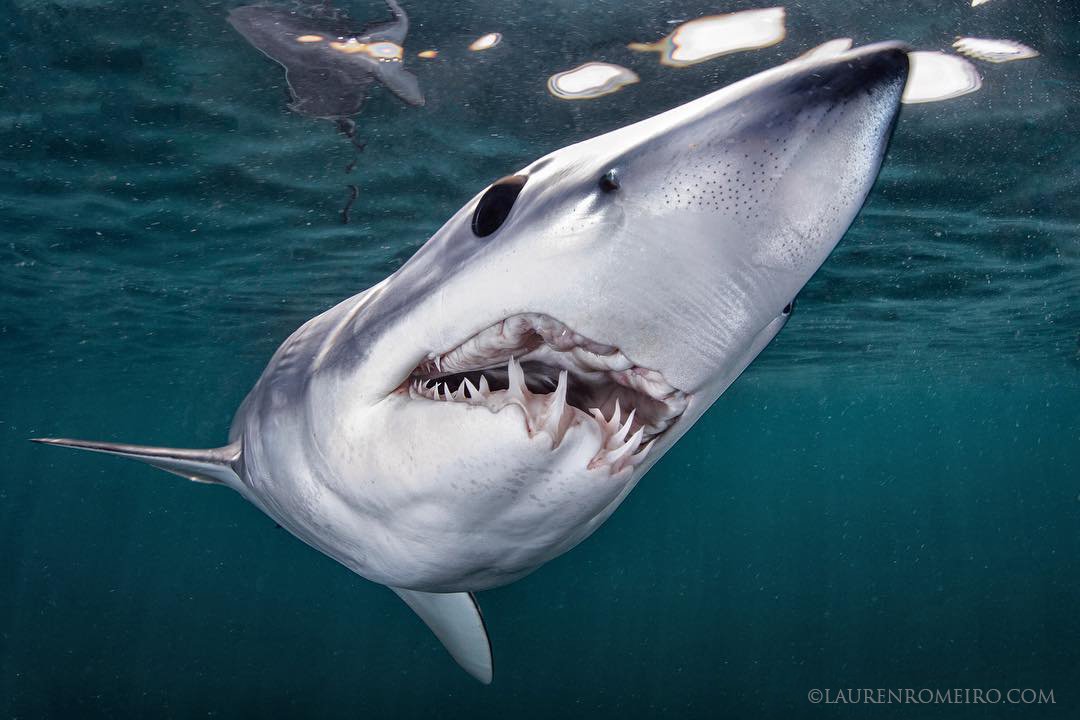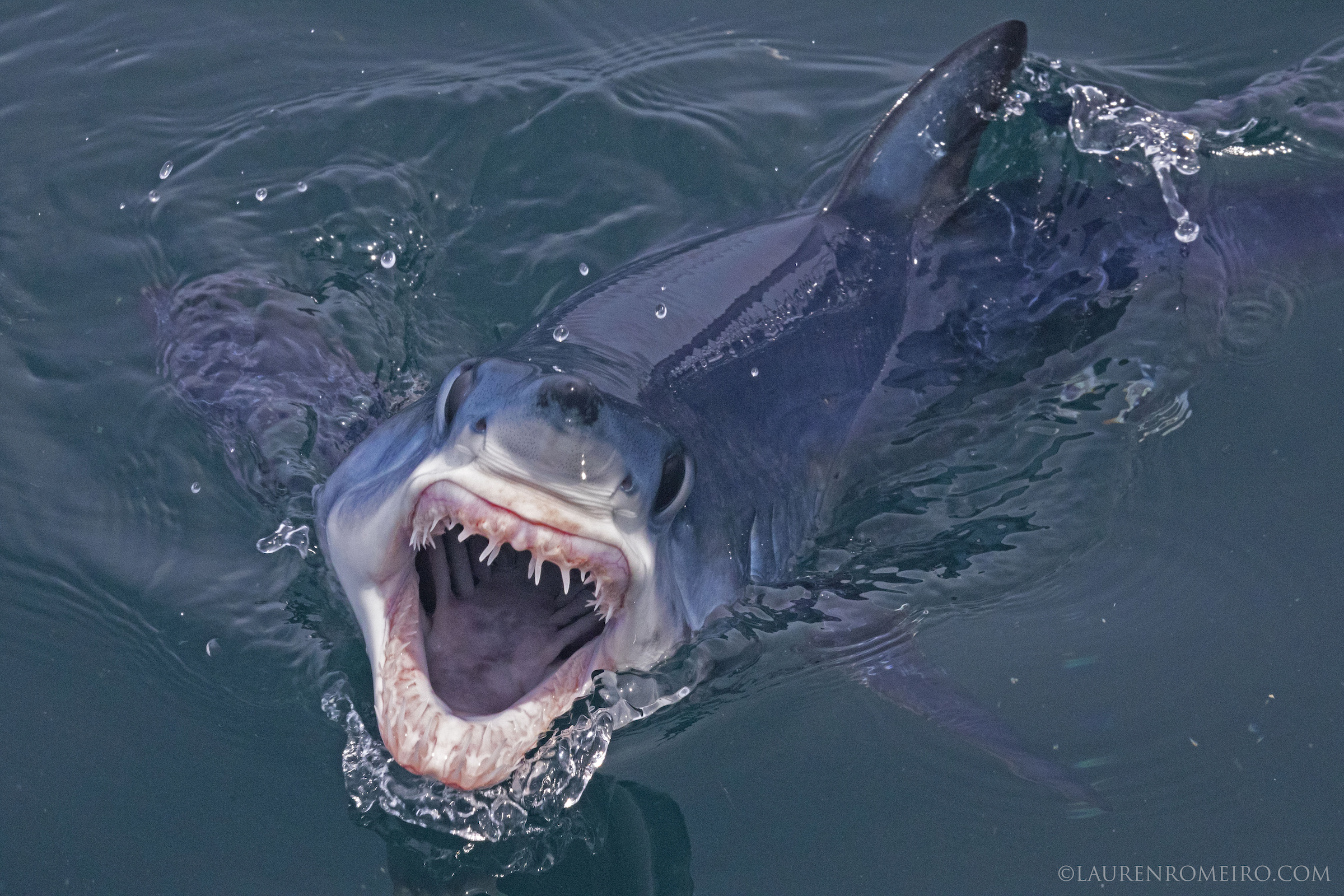Conservation Heroines: Lauren Romeiro
Lauren Romeiro fell in love with sharks the first time she saw one at a young age. Since that day, she followed her dream of protecting sharks and hasn’t let anything stand in her way. Now, she is a marine biologist, filmmaker, and PhD student studying sharks off the coast of New England. Her current project focuses on the mako and blue populations in the area, with the hopes of using her research to establish protected areas. Read on to meet Lauren!
SC: You spent a lot of time on the water growing up. Did you always have an interest in sharks?
LR: I always found wildlife really intriguing growing up. I spent a lot of time on the water since my family owned a boat. It wasn’t until I saw my first shark in the wild that really sparked my interest in them. From there, I began researching all I could about them and it never stopped.
SC: It can be tough to find a job in marine biology, shark conservation, or underwater filmmaking (let alone all three!). How did you get where you are today?
LR: I always had an interest in wildlife filmmaking, but it was one of those dreams where I never thought it was something I could become. I decided to start early and began internships and volunteering while I was nearing the end of high school. In college, I pursued a degree in Marine Biology and moved on to obtain a master’s in Oceanography. I traveled all around the world during college for different internships in shark conservation from Fiji, South Africa, Hawaii, etc. After graduating, I got a job on a sportfishing boat and eventually moved onto another local boat that focused on shark diving, run by Joe. There, I started learning different camera systems and assisting in their setup which led to me getting my own rig. After a year of working there, Joe and I decided to get our own boat. Now, we are combining both of our expertise to spearhead shark research, conservation, and filming here in New England. I have also recently gone back to school to get my PhD.
SC: Your first job out of college was actually on a sportfishing charter. Tell us about that, and how you took that experience and translated into being a conservationist.
LR: Getting a job in the field right after college was extremely difficult. While I was searching, I decided to get a job on a local sportfishing boat to broaden my skills on the water. At the time, the captain also ran shark diving and tagging charters for a few weeks out of the summer, so I was able to gain more experience there. I really enjoyed working for that specific captain and being on the water, however I really did not enjoy fishing or hurting the animals. From that experience, I decided I wanted to focus solely on natural interactions and non-invasive work.
SC: Joe taught you a lot about photography and editing in the early stages of your career. What was the best piece of advice he gave you?
LR: The best piece of advice was to always be practicing and perfecting your craft. It’s a skill that can easily be lost and there’s always new technology and techniques, so if you're always learning as much as you can and never stop you’ll make it.
SC: You spend a lot of time in the water with sharks, and observing them topside. What is the most surprising or memorable thing you've seen?
LR: There are so many amazing encounters that it’s so difficult to just choose one! However, one night far offshore when we saw a 12-foot mako was definitely something I think about every day. Seeing an endangered animal of that size gives you hope that their populations can recover. Another great encounter was another night where we had dolphins hunting small fish and squid that were surrounding the boat due to the lights. This event took place for a few hours and was something really special.
SC: You're currently researching mako and blue sharks off the coast of Rhode Island. What are you expecting to find, and how did you come to the conclusion that these populations needed more studying?
LR: There are a lot of people studying sharks in New England, but I found that they are doing very similar projects that focus on seeing where they go, rather than trying to understand how they are using the area. Being on the water frequently, we have seen really large makos and a lot of female blue sharks, both of which are very rare to see. I was in a great position with all the tools that we have to start something new and really help these animals get protected by determining this area to be critical feeding, mating, and nursery grounds.
SC: What are some of the issues you see affecting sharks in your area? How do you see your current research project helping?
LR: Sharks in our area are greatly affected by fishing, whether that’s for recreation or science. Almost every shark we see by the middle of the summer has a hook or line attached to its jaw, or some sort of damage to its jaw. Sharks do everything with their mouths, and we have to be more careful about how we are handling them in any situation. My project will show that this is an important foraging/breeding/nursery ground for many different species of sharks that come back here year after year, and that we need different management and handling techniques. Their habitats also need to be protected, especially because some of these animals are classified as endangered, threatened or vulnerable.
SC: There have been so many technological advancements in the science world. Tell us about some of the methods and equipment you're currently using.
LR: Technology is constantly advancing, and there is a lot of new equipment that has come out in the past couple of years. We are using eDNA (known as environmental DNA) to determine what animals were in a surrounding area over a period of time (a couple days). All this requires is taking a water sample, filtering it through a pump, and sending it off to a lab for analysis. Normally, to determine which animals reside in an area, you have to drag nets or perform longline surveys. Those methods can be detrimental to both the animals and the environment, and you still won’t be able to determine everything in the area. All animals shed DNA, so even if they just passed through, we can detect them.
Our BRUVs are thether-less and go down to 1,000 meters. They record high-definition video for up to 6 hours and are used to capture behaviors and abundance in hard-to-reach areas, such as the deep ocean. Each one has its own acoustic receiver with a code that is transmitted through a cable hung over the side of the boat. When the code is signaled, the BRUV releases off the weight keeping it on the bottom and returns to the surface.
SC: You've been vocal about not supporting invasive shark research methods. What led to this standpoint?
LR: The problem I see with catching sharks - whether it be for recreation or for science - is you never know who the handler is. You can have a great handler who really cares for the shark and knows when it’s time to let them go, but then you also have a large majority that have no idea what they are doing, and unfortunately, that’s what ruins it. I have seen too many sharks with damaged jaws not being able to eat, with multiple hooks in their mouths, and lines sometimes trailing body lengths behind them. The technology now allows us to get close to these animals and sample them non-invasively while they are free swimming, so there is no need to restrain them anymore. Although it may be harder to do, it is much safer and less stressful on the animal which gives more valuable scientific results.
SC: If you could give one piece of advice to your younger self, what would that be?
LR: Advice to my younger self would be don’t let other people get in the way of doing what you want to do. Everyone is going to have something to say to tear you down, and you will never be able to please everybody. As long as you're doing good work for the animals and enjoy what you are doing, that’s all that matters.
SC: What do you hope to achieve with your work (your current project and beyond)?
LR: I hope that my work makes a difference for sharks and their environment. Now more than ever, shark populations are faced with many different threats that push them further towards extinction. I hope I can show that we can perform non-invasive work that won’t further put the future of these animals in jeopardy. I also hope to show that New England is a very critical area for many different species of sharks and should be protected from development and anything that may damage the habitat.
To keep up with Lauren’s research and photography, as well as 333Productions, you can follow them on social media (@laurenromeiro333 and @333_productions).








